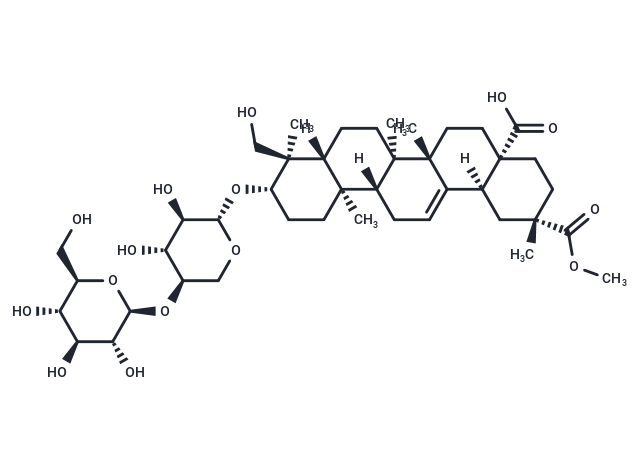Shopping Cart
- Remove All
 Your shopping cart is currently empty
Your shopping cart is currently empty

Esculentoside C exerts proinflammatory effects synergistically, it can induce inflammatory stimulation.

| Pack Size | Price | Availability | Quantity |
|---|---|---|---|
| 5 mg | $630 | Backorder | |
| 1 mL x 10 mM (in DMSO) | $970 | Backorder |
| Description | Esculentoside C exerts proinflammatory effects synergistically, it can induce inflammatory stimulation. |
| In vitro | METHODS AND RESULTS:Petroleum ether (PE), CH2Cl2, n-BuOH, and water fractions were isolated from 70% ethanol extract of P. americana. The n-BuOH fraction was dissolved in 50% ethanol and precipitated by adding ethyl ether. The resultant supernatants and precipitates were referred to as SUPs and SEDs fractions, respectively. SUPs fraction was separated by column chromatography into four main stimulating esculentosides that were identified by HR-ESI/MS and NMR as Esculentoside A(EsA), Esculentoside B(EsB), Esculentoside C(EsC), and Esculentoside F(EsF. The irritating effects of esculentosides on rabbit conjunctivae (500 μg/eye) was observed by pathological examination and those on macrophages (5, 25, 50 and 100 μg/mL) were evaluated by detecting changes of NO, TNF-α, and IL-1β levels.n-BuOH, SUP fractions, and EsC induced severe conjunctival edema. The four esculentosides induced dose-dependent releases of proinflammatory mediators NO, TNF-α, and IL-1β from macrophages, and releasing amounts peaked after 2 h of treatment. EsC and EsF induced macrophages to release mediators most significantly. EsC (50 μg/mL) functioned more effectively than EsF did, and similarly n-BuOH and SUPs fractions functioned more effectively than the esculentoside mixture. CONCLUSIONS: Thus, the four esculentosides exerted proinflammatory effects synergistically.All extracted esculentosides, especially EsC, induced inflammatory stimulation. Phytolacca americana-induced irritation of the gastrointestinal tract may be associated with esculentosides such as EsC. |
| Molecular Weight | 810.975 |
| Formula | C42H66O15 |
| Cas No. | 65931-92-2 |
| Relative Density. | 1.387g/cm3 |
| Storage | Powder: -20°C for 3 years | In solvent: -80°C for 1 year | Shipping with blue ice. |

Copyright © 2015-2025 TargetMol Chemicals Inc. All Rights Reserved.